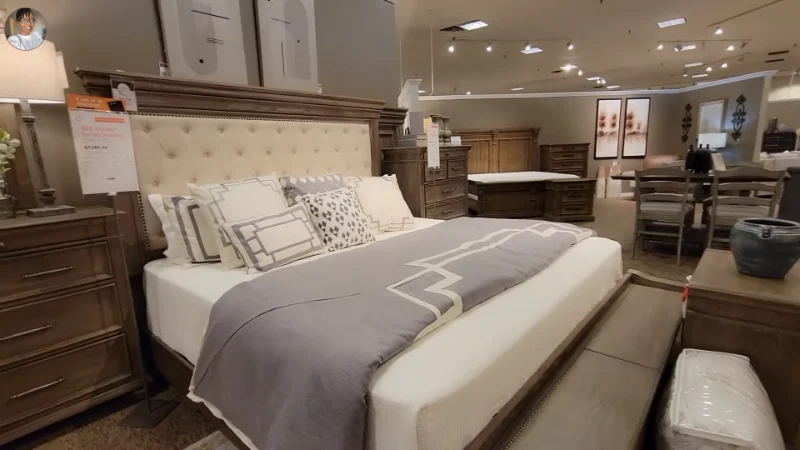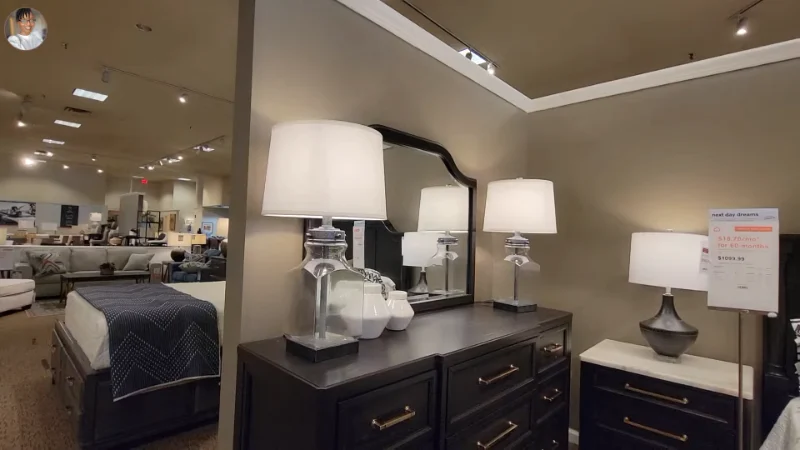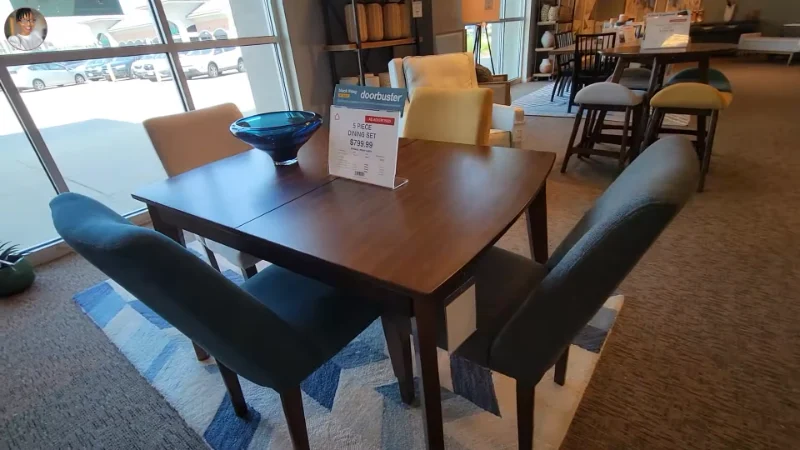Is Ashley Furniture Good? Quality & Where It’s Made
Walk into any furniture showroom, browse online, or simply drive down a commercial street, and you’ll see the name: Ashley Furniture. It’s one of the largest and most ubiquitous furniture manufacturers in the world. Yet, it’s also one of the most polarizing. For every person who loves their affordable and stylish Ashley sofa, there’s another who complains about a wobbly dresser or sagging cushions.
So, what’s the truth? Is Ashley Furniture good quality?
The simple answer, and the reason for all the confusion, is that this is the wrong question to ask. The generic articles that give you a vague “it depends” are failing to tell you the most critical secret about the brand: there is no single “Ashley Furniture.” The brand is a massive conglomerate of distinct sub-brands, each with its own target audience, price point, and quality standard.
This is not another surface-level review. This is a deep dive. We will dissect the different “Ashleys,” uncover the truth about where and how their furniture is made, and, most importantly, teach you how to become a furniture detective. By the end of this guide, you won’t need to ask if Ashley Furniture is good quality; you’ll know how to identify a well-made piece for yourself.
The Most Important Question You’re Not Asking: “Which Ashley Furniture?”

Thinking of all Ashley products as having the same quality is like assuming every vehicle made by General Motors is a Chevrolet Spark. The company produces everything from budget-friendly basics to the more luxurious Cadillac Escalade. Ashley operates on the same principle through its distinct product lines. Understanding these is the first step to making a smart purchase.
Signature Design by Ashley: The Mainstream Powerhouse
This is the Ashley you see most often. It’s their largest, most diverse, and most affordable line, found in their corporate showrooms, on their website, and at major retailers.
- Target Audience: First-time homebuyers, students, families on a budget, and anyone who likes to update their decor with current trends without a massive financial commitment.
- Typical Materials & Construction: This line is engineered for affordability. You’ll primarily find MDF (medium-density fiberboard) and particleboard cores wrapped in wood veneers or decorative laminates. Upholstery frames are often made from a mix of plywood and engineered wood. Fabrics are typically durable but cost-effective polyesters and synthetic blends.
- Quality Expectation: Signature Design pieces are stylish and functional for their price. They are perfect for lower-traffic areas (like a guest room dresser) or for situations where longevity is not the primary concern (a college apartment sofa). With proper care, they can last for several years, but they are not designed to be multi-generational, heirloom pieces.
Millennium® by Ashley: The Aspirational Step-Up
If Signature Design is the Chevrolet, Millennium is the Buick or GMC. This is Ashley’s higher-end collection, designed to compete with more expensive brands like Pottery Barn or Crate & Barrel, but at a more accessible price point.
- Target Audience: Second-time homebuyers or established households looking for a more substantial, refined look and feel without entering the luxury price bracket.
- Typical Materials & Construction: The difference here is tangible. You’ll find a greater use of solid wood for frames, legs, and trim. Case goods (dressers, tables) often feature thicker veneers over more robust engineered wood cores. You’ll see better construction techniques, such as sturdier joinery in drawers (sometimes including dovetails), higher-quality hardware, and more premium upholstery options, including top-grain leather. The pieces are physically heavier and feel more solid.
- Quality Expectation: Millennium furniture is built to a higher standard. It’s designed to withstand the rigors of daily family life and maintain its appearance for many years. This line represents a significant step up in durability and is often where you’ll find the best balance of price and quality within the Ashley portfolio.

Benchcraft®: The Urban and Modern Aesthetic
Benchcraft is a line that often focuses on contemporary, mid-century modern, and urban-inspired designs. It carves out a stylistic niche that appeals to a younger, more design-conscious demographic.
- Target Audience: Apartment dwellers, fans of modern design, and those looking for clean lines and a more minimalist feel.
- Typical Materials & Construction: The quality level of Benchcraft often sits somewhere between Signature Design and Millennium, depending on the specific piece. The focus is on achieving a particular style efficiently. You’ll see a mix of materials, including engineered woods, metal accents, and a wide array of textured fabrics.
- Quality Expectation: Similar to Signature Design, but with a stronger emphasis on style. The durability is generally good for the price point, designed for modern living where spaces and needs might change more frequently.
“Where Is Ashley Furniture Made?” The Hybrid Model Explained
This is the second piece of the puzzle. The “Made In” tag is not as straightforward as you might think. Ashley Furniture proudly boasts of its American roots and significant U.S. manufacturing presence, including massive facilities in Arcadia, Wisconsin. However, it is a global company with a vast and complex international supply chain.
The key that no one talks about is this: Ashley uses a global parts and hybrid manufacturing model. This means a single piece of furniture may not be from a single country.

What’s Made & Assembled in the USA?
Ashley’s U.S. facilities (in Wisconsin, Mississippi, North Carolina, and Pennsylvania) are manufacturing and logistics powerhouses. They primarily focus on:
- Upholstered Furniture: A significant portion of their sofas, sectionals, loveseats, and chairs are assembled in the United States. This allows them to respond quickly to market demands. However, the components—the wooden frame, the springs, the fabric—may be sourced from various countries. Final assembly happens stateside.
- Mattress Production: Their Ashley-Sleep® mattresses are also largely produced in their U.S. plants.
- Distribution & Logistics: Their American facilities are the central nervous system of their massive distribution network for North America.
Bob’s vs Ashley Furniture Quality: Don’t Get Ripped Off
The Global Supply Chain: Vietnam, China, and Beyond
The majority of Ashley’s “case goods”—which includes any non-upholstered, hard furniture like dressers, nightstands, dining tables, chairs, and bookshelves—are manufactured overseas, primarily in Vietnam and China.
- Why? Manufacturing wood furniture is a labor-intensive process. Sourcing from countries with lower labor costs allows Ashley to offer furniture at such competitive prices.
- What Does This Mean for Quality? This is the source of much of the brand’s quality inconsistency. While Ashley maintains quality control standards in its overseas factories, the sheer volume of production can lead to variances. A batch of dressers from one factory might be flawless, while another might have minor finishing issues. This is why personally inspecting the furniture before purchase or upon delivery is absolutely critical.

How to Become an Ashley Furniture Quality Detective: Your Showroom Guide
This is where you take control. Instead of relying on a salesperson or an online review, you can learn to assess the quality of a specific piece of furniture yourself. These are found cheaper online than market. Use this checklist next time you’re in a store.
The Wood Furniture Autopsy
- The Wobble Test: This is the simplest and most important test. Place your hands on a dresser or table and gently try to rock it side-to-side. A well-made piece will feel solid and rigid. If it wobbles, twists, or creaks, it’s a major red flag for poor joinery and a weak frame.
- The Drawer G-Force Test: Don’t just open a drawer; pull it all the way out.
- Glides: Are the glides smooth metal ball-bearing systems, or a cheap center-mount wood or plastic glide? Better glides are a sign of higher quality.
- Joinery: Look at the corners of the drawer box. Can you see interlocking joinery like dovetails (the gold standard)? Or is it simply glued and stapled together? Staples are a sign of a budget-minded construction that may not hold up to heavy use.
- Bottoms: Is the drawer bottom a flimsy, paper-thin piece of hardboard that will sag under the weight of clothes? Or is it a thicker, reinforced panel?
- The Veneer & Finish Inspection: Look closely at the surface. A good quality veneer will be smooth, with no lifting or bubbling at the edges. Run your hand over it. A cheap laminate will feel plasticky and slick, while a real wood veneer will have a subtle texture. Check for inconsistencies in the stain and finish, especially in less visible areas.

The Upholstery Investigation
- The Cushion Density Check: The lifespan of a sofa is often determined by its cushions.
- The Sit Test: Sit on the cushion. Does it support you, or do you sink right through to the frame?
- The Squeeze Test: Grab a seat cushion and squeeze it. High-density foam will feel substantial and spring back to shape quickly. Low-density foam feels light, airy, and collapses easily. This cheap foam is what leads to sagging seats within a year or two. Ask the salesperson for the foam density rating; 1.8 lbs per cubic foot (PCF) or higher is a good standard for durability. This is a pro-level question that signals you know what you’re looking for.
- The Frame Feel: Run your hands along the arms and back of the sofa. Can you feel the hard edges of the frame through thin padding? A quality piece will have generous padding over all frame components. Ask what the frame is made of. The gold standard is “kiln-dried hardwood,” which prevents warping. Plywood and engineered wood are acceptable in budget-friendly pieces but are less durable.
- The Truth About “Leather”: This is one of the most misunderstood aspects of Ashley furniture and the source of many complaints. It is crucial to know the difference.
- Bonded Leather (Often Marketed as DuraBlend®): This is the material behind most “peeling leather” complaints. It is not real leather. It’s a composite material made of leather scraps and fibers shredded and bonded together with polyurethane onto a fabric backing. It can look great initially but is notorious for peeling and flaking over time, especially with use and exposure to sunlight or cleaning products. If you see “DuraBlend,” understand you are buying a fabric, not leather.
- Leather Match / Leather Seating: This is a common and effective cost-saving method. The manufacturer uses real top-grain leather on the parts of the furniture your body touches (seat cushions, backrests, armrests) and a perfectly matched vinyl (faux leather) on the sides and back. This offers the feel and durability of real leather in key areas at a lower price.
- Top-Grain Leather: This is high-quality, durable leather used on their more premium pieces, often in the Millennium® line. This material is designed for longevity and will not peel like bonded leather.
Conclusion: So, Is Ashley Furniture the Right Investment for YOU?
After peeling back the layers, the answer becomes clear. Ashley Furniture’s quality isn’t a simple “yes” or “no.” It is a calculated equation of Sub-Brand + Materials + Price Point + Your Personal Needs.
Ashley Furniture is an EXCELLENT choice for:
- First-Time Homeowners & Students: You can furnish an entire home stylishly without going into major debt.
- Decorating on a Budget: Their massive selection and competitive pricing are unmatched.
- Furnishing Low-Traffic Areas: A Signature Design chest in a guest room is a perfect, cost-effective solution.
- Those Who Love Trends: If you enjoy changing your home’s style every few years, you won’t feel guilty about replacing a trendy but affordable Ashley piece.
You should probably look at other brands if:
- You Are Seeking “Heirloom Quality”: You want furniture made from 100% solid wood to be passed down through generations.
- You Prioritize “Made in America” for All Components: Theirs is a global supply chain, even for items assembled domestically.
- Your Budget Allows for a Higher Tier: If you can comfortably afford brands known for solid wood construction and domestic manufacturing, you will generally get a longer-lasting product.
Ultimately, Ashley Furniture serves a vital purpose in the market. It makes stylish, functional furniture accessible to millions. By using the detective skills you’ve learned here—by identifying the sub-brand, testing the drawers, squeezing the cushions, and specifically identifying the type of “leather” used—you can navigate their vast catalog with confidence. You can find the well-made gems within their collection and choose a piece that offers fantastic value for your home, your budget, and your life.
